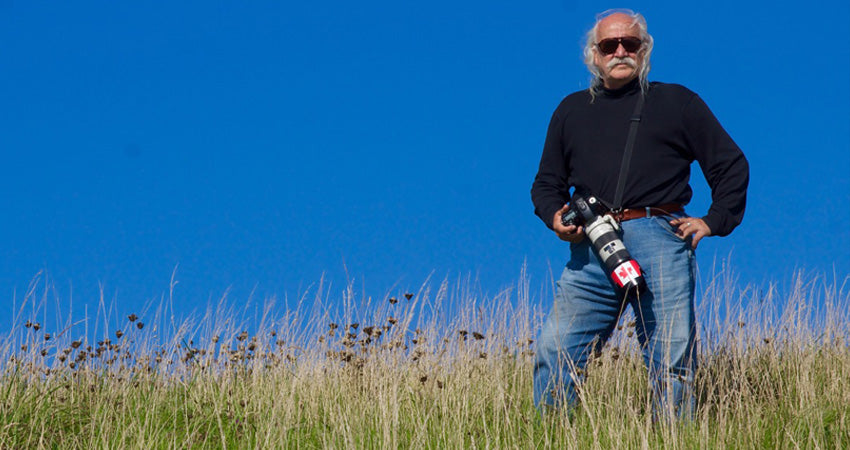What's on

50 Years of F1 in Canada - The Mosport Years - Vol.2
To commemorate 50 years of Formula 1 racing in Canada, CTMP is compiling some of Mosport’s greatest F1 stories through personal memories from household names of Canadian motorsport…
ALLAN DE LA PLANTE: THE PHOTOGRAPHER
If you ask the legendary Allan de la Plante how he got where he is today, he’ll probably just say “I got lucky.” For the humble resident of Burnaby, BC - there’s a lot more to it than luck.
As a photographer de la Plante covered the 1974 Canada-Russia hockey series, the 1976 Olympic Games in Montreal, Pope John Paul II’s Canadian tour in 1984, and countless other subjects from firefighting to horse-racing.
Some of his best known work was compiled in the 1995 book, Villeneuve: A Racing Legend - which documented the career of Gilles Villeneuve during Allan’s time as his close friend and photographer.
De la Plante’s foray into journalism and photography began at Canadian Tire Motorsport Park, then known as Mosport Park, during the Formula 1 years of the late 1960’s and 1970’s.
“I started going in 1967,” de la Plante says. “I wasn't taking pictures for the first couple years, I went with a bunch of friends and it's still a bit of a haze but I knew I had to get involved in the sport somehow.”
He remembers that inaugural Canadian Grand Prix in 1967 fondly, saying “it was a sea of people and tents. It was really an amazing place to be.”
Keen to get involved at Mosport, by 1969 de la Plante was getting into photography and began hanging around motorsport journalists looking for a way in.
“F. David Stone was the one in charge of credentials at the time. I used to go find him to chat for a bit. He had no idea that I was actually sizing up his credentials.”
Coloured pencils and paper in hand, Allan would sneak back to his car to draw up his own media credentials. Tucked inside a plastic case, he says “no one could tell the difference.”
“I had fake credentials…I never had legal right to be there, but that was my way to get in,” he says.
What Allan didn’t know was that someone had been watching him, but was letting him get away with having fake passes. Harvey Hudes, Mosport Park track owner at the time, had been keeping his eye on young de la Plante and was impressed with his work.
“I ran into Harvey one day and he said ‘why don’t you send me a letter, and I will give you real credentials…I’ve been watching your work and I’d like to have you around here.’ He was quite a mentor to me and a very good friend as well.”
With Harvey’s help, de la Plante was creating posters from Mosport owned images. They were selling fast.
By 1972 de la Plante continued to take pictures, but wanted to steer away from being strictly an entrepreneur so he could photograph and create portraits for drivers, teams, and sponsors.

Paul Cooke, Canadian Motorsport Hall of Fame Inductee and Vice President of Competition at ASN Canada FIA, was the team manager and chief mechanic for Can-Am driver Roger McCaig. Paul asked Allan to do a portrait that he could give Roger for Christmas.
At this point de la Plante was confused by the word portrait. Should he use just the driver's face, with a focus on the eyes, or an action shot of the car?
“I thought, if I could find a way to blend the two images together, I'd have a true portrait…it really became my signature.”
Perhaps Allan’s most iconic portrait in this style, is of Gilles Villeneuve at Mosport in 1977 - but we’ll get to that.
Allan’s new style of portrait was selling well. He would create the portraits first, then take them around to various drivers and sponsors; naturally they were for sale.
In 1973, Allan took notice of Gilles Villeneuve and his wild driving style during a Formula Ford race at Mosport.
“I was standing at Turn 10. Gilles came around in a full-on power-slide lap after lap. It was pretty incredible.”
In 1974 Villeneuve was now in a Formula Atlantic car sponsored by Shweppes. He was becoming very noticeable, but left the track at Mosport's Turn Three after a collision with Rick Morris. Villeneuve broke his leg in the incident, but continued in pain to the end of the season.
By 1975 Villeneuve was now sponsored by Skiroule, who sponsored him in skidoo racing as well. Allan saw an opportunity to sell some portraits to the sponsor. Walking through the paddock one afternoon, Allan and Gilles struck up a conversation and de la Plante invited him to stop by that evening to his motor-home in the lower-paddock to take a look at a portrait he had done of him.
At around 10 o’clock there was a knock on the motor-home door.
“I’m just about ready to hit the rack…and I open the door and there’s Gilles and Joann standing there. So they come in and we shot the breeze for a while and I showed Gilles two portraits I had done at St. Jovite. He said he didn’t have any money, which I was already aware of, but he wanted one for his father. So I said why don't you take one and sign the other one for my collection.”

In 1976, Villenueve caught the eye of Formula 1 managers when he beat a field of Formula 1 stars, including 1976 world-champion James Hunt at the Formula Atlantic race in Trois-Rivieres, Quebec.
Hunt spoke to McLaren boss Teddy Mayer raving about Villeneuve’s skill, and the team signed him to a deal that would see Villeneuve make his Formula 1 debut at the 1977 British Grand Prix.
Jumping into a Formula 1 car for the first time and finishing the race in 11th was no easy feat, but McLaren decided to select Patrick Tambay for its 1978 Formula 1 season, and Villeneuve was out.
Enzo Ferrari felt the young Canadian could be a World Champion in the making and the team signed Villeneuve to run the last two races of the 1977 season, and the full 1978 Formula 1 campaign.
This meant Villeneuve would make his Scuderia Ferrari debut at the Canadian Grand Prix at Mosport in 1977.
Gaston Parent, Villeneuve’s mentor and manager, suggested to Gilles that he should find a photographer to document his exciting journey into Formula 1 - essentially to record his life through photographs. Villeneuve told Parent he had someone in mind.
“I just got lucky,” de la Plante says.
“I was right in front of the Ferrari the first time he actually sat in it on the grid at Mosport. I got images of him there. He was so relaxed, he was so cool. It was as if he knew that he belonged there. It was an amazing time.”
The image de la Plante took at that moment became a Villeneuve fan favourite.

“It’s a classic image to me...Gilles is just sitting there like he is about to drive to McDonalds. He was so relaxed. Anybody else in this world, in that circumstance, would have just been so wired and full of adrenaline.”
De la Plante and Villeneuve’s relationship continued throughout the driver’s impressive, but tragically short-lived Formula 1 career, when he was killed during qualifying for the 1982 Belgian Grand Prix at Zolder.
After that, de la Plante didn’t photograph motorsport for a long time, but returned in 2013 to Canadian Tire Motorsport to shoot the inaugural Chevrolet Silverado 250 NASCAR Camping World Truck Series race.
Although he is probably most well-known for his work during his time as Villeneuve’s photographer and close friend, arguably his most legendary photograph was taken a year before he embarked on the historic Formula 1 journey with Ferrari.
In 1976 de la Plante was covering the Canadian Grand Prix when he captured one of the greatest images in Formula 1 history.
“I’m always trying to get something that nobody has ever seen, something from a different angle.”
De la Plante says back then he had never seen any photos taken from down-low on the outside of Turn Four.
"It is an extremely dangerous place to be,” de la Plante says. Even today, access is restricted to photographers further down the corner.
Allan made a point of getting to know the corner marshals, knowing that he would get less hassle from them if he wanted access to spots that were a bit more restricted. When he asked a corner marshal at Turn Four if he could go down near the bottom of the guardrail for the first few laps of the race, the marshal told him it would be alright as long as he stayed low and kept on his toes.
“I realized on the pace lap that I could actually see underneath the cars a flash of sky,” he says. “I could see there was an opportunity to get something really good, but I didn't expect it to be what it is.”
At the start of the Grand Prix, the first four cars were extremely close, all jockeying for position. Although James Hunt had been on pole, Ronnie Peterson managed to get past him, with Patrick Depailler in the Tyrrell, and Mario Andretti in the Lotus tucked in behind.

Heading down into Turn Four the cars would have been doing around 220 km/h. Allan says, “the chances of me getting that photo were probably one in a thousand. I just got lucky.”
Earlier this summer, Formula 1 cars from the 1970's returned to Canadian Tire Motorsport Park with the FIA Masters Historic Formula 1 Race Series. Among them was the T4 Ferrari that Villeneuve had driven in 1979. De la Plante had heard the car would make an appearance, and be driven in anger once again. He said he just wanted to hear the Ferrari "sing" once more.
De la Plante returned to see, hear, and again record an image of one of his friend's favourite cars. His return brought full circle the journey that started so long ago in the Ontario country-side that was once called Mosport Park.

Archives
- September 2023
- June 2023
- January 2023
- May 2022
- January 2022
- August 2021
- April 2021
- December 2020
- July 2020
- June 2020
- May 2020
-
- Castrol espeedfest full weekend race rundown
- Mosport karting centre: returning to the track phase 1
- Virtual marketplace: castrol espeedfest contests & promotions
- Official entry lists: castrol victoria day espeedfest
- 2020 imsa mobil 1 sportscar grand prix cancelled
- Victoria day goes virtual with castrol espeedfest
- April 2020
- March 2020
- February 2020
- December 2019
- August 2019
- May 2019
- March 2019
- January 2019
- October 2018
- August 2018



